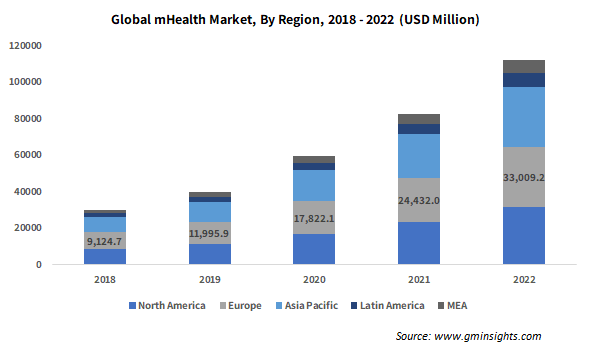Home > Healthcare > Healthcare IT > Payer/Provider Solutions > mHealth Market
mHealth Market Analysis
- Report ID: GMI286
- Published Date: Dec 2022
- Report Format: PDF
mHealth Market Analysis
mHealth market from the wearable devices product segment is expected to cross USD 171 billion through 2032. The notable revenue share is attributed to multiple prime advantages offered by the product, including better accessibility to clinical information. The COVID-19 pandemic had a positive influence on the wearable devices demand, as the need to monitor vital healthcare parameters regularly surged significantly. As per some estimates, about one-fifth of the U.S. population wore a smart wearable technology in 2021. Adequate application of wearable devices in measuring and overviewing the heart health, physical attributes, blood glucose levels, temperature, and medication compliance among others would further drive their adoption.
|
Global mHealth Market Share, By Application, 2022 (%) |
|
|
Segment |
Global market share |
| Communication and Training | 5.39% |
| Education and Awareness | 7.02% |
| Diagnostics and Treatment | 24.08% |
| Disease and Epidemic Outbreak Tracking | 11.36% |
| Remote Data Collection | 8.86% |
| Remote Monitoring | 40.55% |
| Others | 2.74% |
mHealth market from diagnostics and treatment application segment is anticipated to grow at more than 21% CAGR through 2032. This is attributed to the rising prevalence of various chronic conditions. Patients suffering from cardiovascular diseases, diabetes, and neurological disorders, require real-time monitoring of their health conditions. Catering to needs of this growing patient pool, Peerbridge Health designed the Peerbridge Cor System that offers portable ECG diagnostics. The FDA regulated wearable modality targets AFib along with other arrhythmias. Such notable developments by leading companies are set to drive the segment expansion.
mHealth market from the patients’ segment is projected to reach USD 190.5 billion by 2032. The considerable revenue share is majorly attributed to the increasing awareness among individuals for regulating vital parameters including body temperature, heart health, mental wellbeing, sleep duration, and physical fitness. Moreover, the growing emphasis on mHealth due to quick internet access will accelerate the product adoption.

Asia Pacific mHealth market was valued at more than USD 32.5 billion in 2022 and is anticipated to showcase over 23% CAGR through 2032. The regional healthcare industry is moving toward digitization of their operations in a bid to improve the patient experience. With 76% of healthcare practitioners in the nation presently utilizing DHRs in their operations, India is a forerunner in the adoption of digital health technologies. Various governments in the continent are expected to launch multiple mHealth related solutions in the future, thereby augmenting the regional market statistics.

